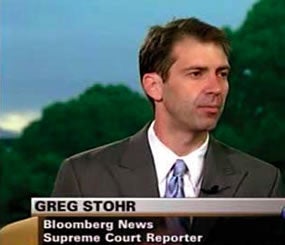Getting it in first, and getting it right
Not every U.S. Supreme Court decision is awaited by a breathless nation. But when an issue strikes fire with the greater populace, those tasked with covering the high court had better get it right.
When the justices ruled on President Obama’s health care law this summer, Greg Stohr was first, and Greg Stohr was right.
Stohr ’95, who covers the Court for Bloomberg, is credited with having delivered the decision to the news wires just 52 seconds after Chief Justice John G. Roberts Jr. ’79 began speaking, the equivalent of a gold-medal win in the Olympics of news delivery, made even more impressive because the decision was initially misreported by other outlets, most notably CNN (an epic fail in the Olympics of news delivery).
So how did Stohr beat out everyone else? Foremost, he remained calm.
While the justices took their places in the courtroom on the morning of June 28, “the atmosphere [was] tense with anticipation,” reported Tom Goldstein, who teaches at HLS and is publisher of SCOTUSblog, which also covered the decision and later analyzed the timing of media response.
Downstairs in tiny public information room G42, more than a dozen reporters, including Stohr, stood waiting to receive hard copies of the decision. Television reporters perched outside on the courthouse steps.
The nation’s reception of this much-awaited opinion would depend wholly on the journalists’ interpretation: For approximately the first half-hour, the Court’s own website would crash, and no one outside the Court would have access to the actual opinion for what amounted to eons in news time.
At 10 a.m. in G42, reporters focused on a well-guarded large white box, which held copies of the printed decisions.
“We’re pretty collegial,” Stohr says. “The competition [usually] has to do with who can write the best story explaining what the Court just did. … There really are few scoops.”
But that day, there was a scoop to be had. While eager to be fast, Stohr was aware of the potential for error in reporting the nuanced opinion, which came after three days of oral arguments in March over challenges to the controversial health care law brought by 26 states and other plaintiffs.
At 10:06:40, the chief justice began delivering the Court’s decision by stating, “I have the announcement in …”
The white box was opened.
Six seconds later, at 10:06:46, Bloomberg was the first to publish that a decision had been issued.
That was the easy part, says Stohr. Now the race was on to figure out what the decision was.
Stohr says he tried ahead of time “to think through all the shades of gray that could occur” with the decision, which ultimately proved key because, in the syllabus that dozens of journalists and their teams were frantically scanning, the Court wrote first that the individual mandate was not a valid exercise of Congress’s power under the commerce clause.
“I think everybody’s first reaction was, ‘Wow, it reads like they struck it down,’” Stohr says.
In fact, as those who kept reading would discover, the syllabus went on to state that the individual mandate was valid under Congress’s tax power.
At 10:07:32, 52 seconds after Roberts began to speak and reporters got the paper decision, Stohr had correctly analyzed it and published the headline “Obama’s Health-Care Overhaul Upheld by U.S. Supreme Court.”
Reuters, AP, Dow Jones and other outlets followed; Fox and CNN would later have to change course on their initial reports that the mandate had been struck down (at 10:07:39 and 10:07:44, respectively).
For Stohr, who has been covering the Court since 1998 and loves “seeing history firsthand,” it was a chance to be part of history—but not in the same way CNN and Fox were.
“We’re in a world where people expect to get things immediately,” Stohr reflects. “With the health care decision, I was absolutely going to get that out as fast as I could … but only as soon as I was confident we had the right answer.”
